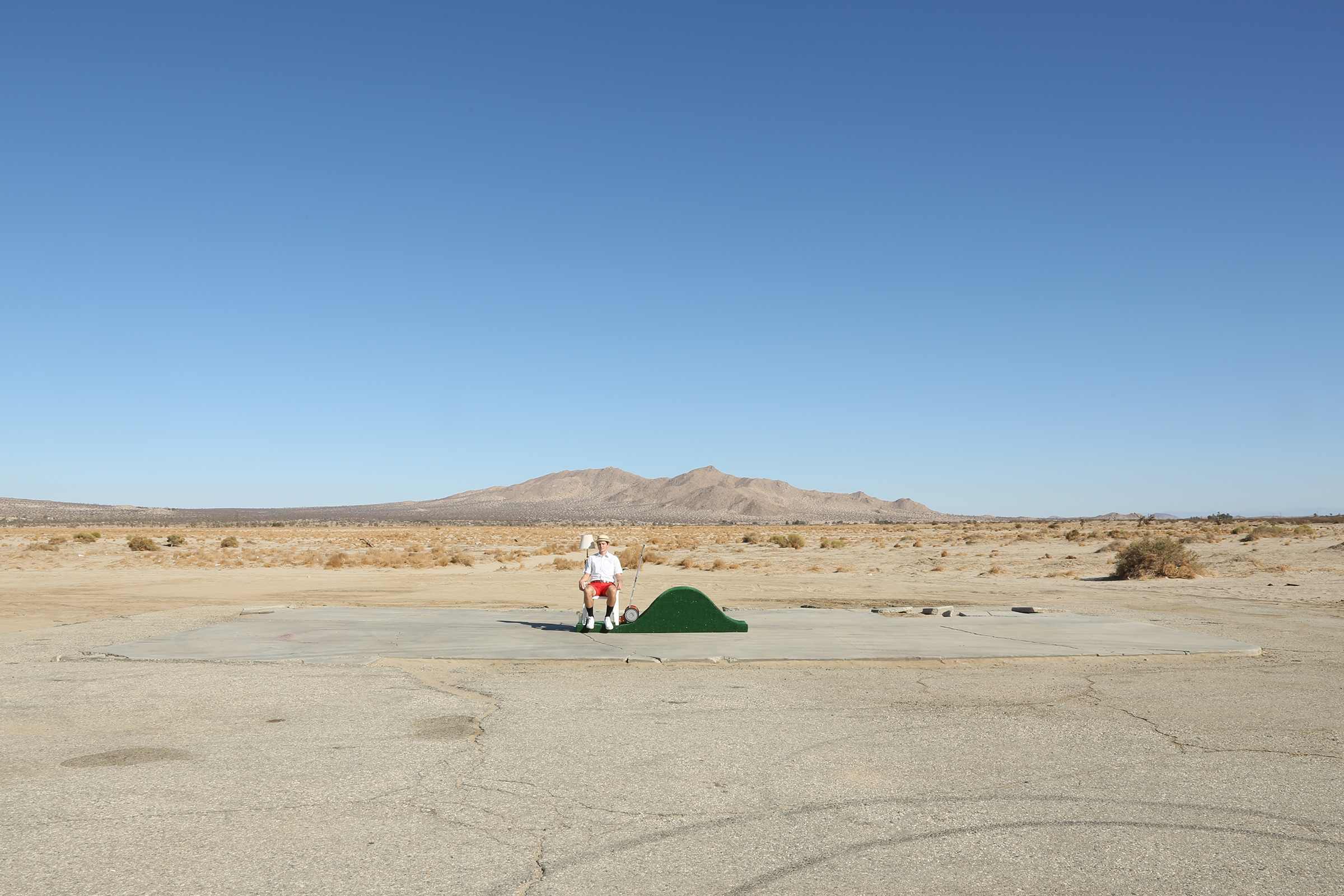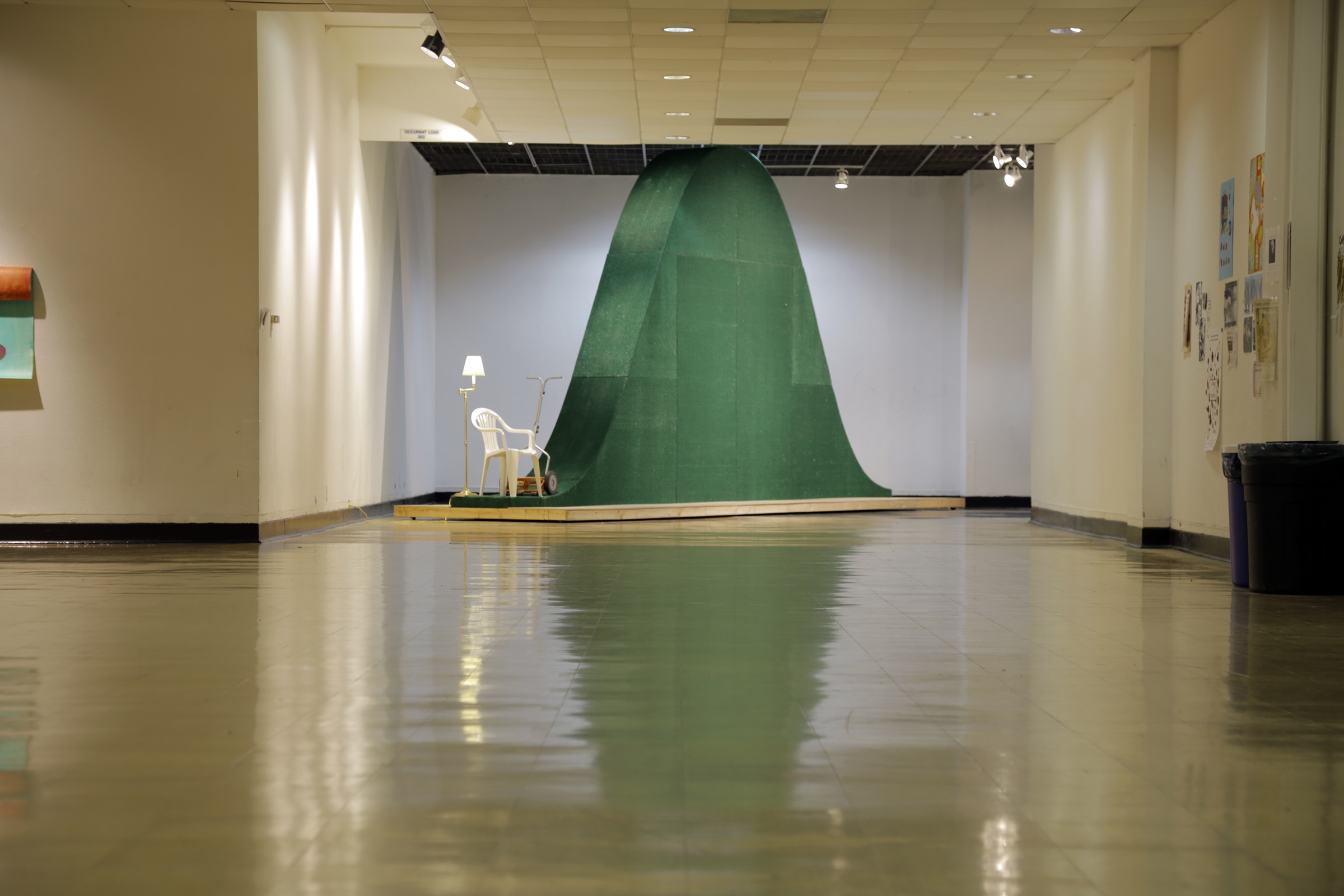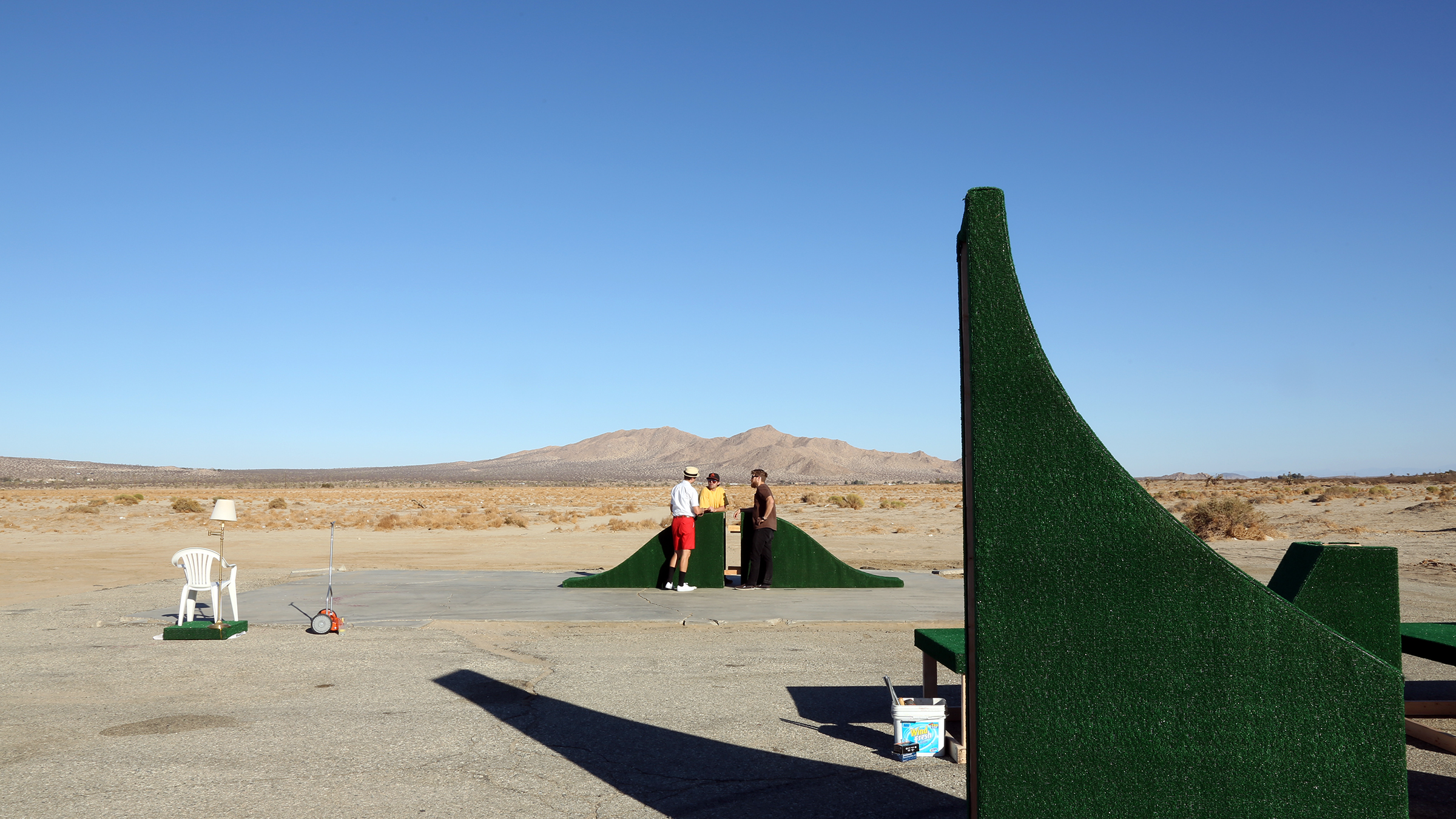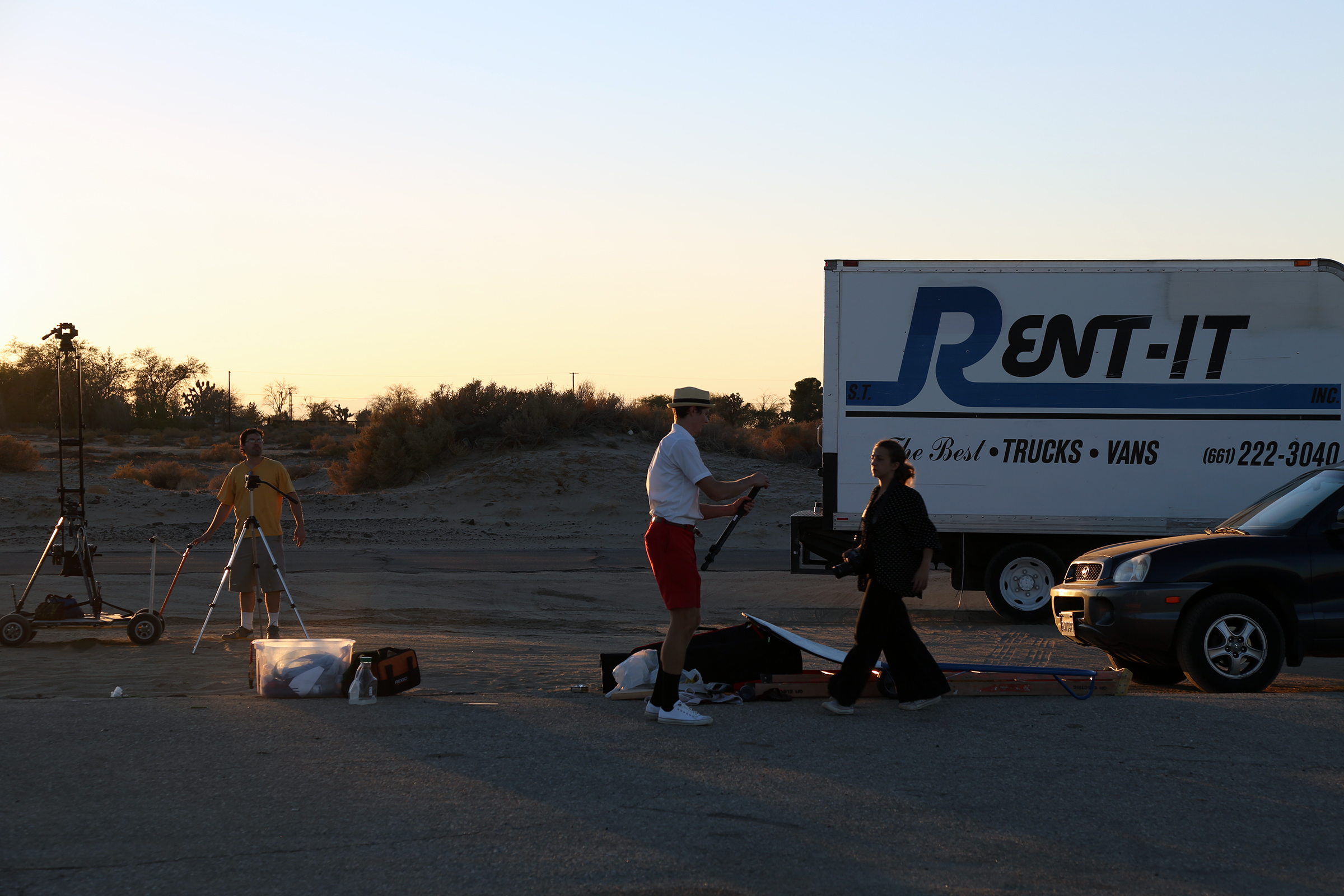Mowing the Lawn
Mowing the Lawn
2013
The Drop by Pelican Bomb - New Orleans, LA
Art San Diego art fair - San Diego, CA
L-Shape Gallery CalArts - Valencia, CA
In Mowing the Lawn, a character mows a mound of artificial turf that periodically grows. This piece started as a performance that accompanied an image. In 2013, I created an edition of 100 screen prints of a person mowing a lawn. The work was commissioned by Pelican Bomb, a subscription art service started by Cameron Shaw and Amanda Brinkman. In my first year of graduate school at the California Institute of the Arts, I expanded the performance into a short video.
I used the piece to process some thoughts about property, work, motivation, futility and the absurd. I found inspiration in Sisyphus, of course, as well as the history of development in the high desert of Antelope Valley, CA, where this video was created.
Initially, I was attracted to Antelope Valley as a production location because of its barren, parched landscape. It seemed ideal to make a video about the growth of fake grass in the high desert. I found the actual site, an empty concrete pad in front of an isolated mountain, with google maps. Driving from CalArts to inspect the site, I passed over a portion of the Los Angeles Aqueduct, William Mulholland’s early 20th-century mega-project that moisturizes L.A. County. It’s a river of concrete skimmed with water that flows from Owens Lake to Los Angeles, traversing hundreds of miles of desert. The aqueduct helped create the L.A. megalopolis and enabled communities along its inhospitable route to pop up as artificial oases, like those in Antelope Valley.
Then I started reading City of Quartz by Mike Davis. The book opens with the story of Llano del Rio, a community of folks who relocated to the Antelope Valley to live cooperatively and collectively. It lasted only four years. The attempt seemed noble; a group of people attempting to live communally, to embrace an alternative way of being in the world. But in the desert?
Llano del Rio was not the last attempt at community-building in the area. It certainly was not the first: the L.A. County Library system estimates that native folks populated the area for about 11,000 years before the first white settlements were established during the 1840s gold rush. Then came stage coaches and trains and aqueducts and, ultimately, highways. For the last 11,200 years or so, indigenous folks and settlers and colonists and communists and developers and commuters have found reason and means to live in the Antelope Valley. Initially, I ridiculed this desire to make the high desert home. Then I got curious. What motivates us to make and maintain our homes? Does living in a place necessitate that we exploit that place? If we modify our environment, if we make and maintain a home, have we necessarily created artifice, suffocating the natural, the real? Does that make us, uh, bad?
We shot the video on 150 St. E, between Avenues K and M, just down the road from the Club Ed Movie Set, which is notable only for 1991’s Eye of the Storm with Laura Flynn Boyle and Dennis Hopper, a not very notable movie. Afterwards, we ate dinner at Charlie Brown Farms.
2013
The Drop by Pelican Bomb - New Orleans, LA
Art San Diego art fair - San Diego, CA
L-Shape Gallery CalArts - Valencia, CA
In Mowing the Lawn, a character mows a mound of artificial turf that periodically grows. This piece started as a performance that accompanied an image. In 2013, I created an edition of 100 screen prints of a person mowing a lawn. The work was commissioned by Pelican Bomb, a subscription art service started by Cameron Shaw and Amanda Brinkman. In my first year of graduate school at the California Institute of the Arts, I expanded the performance into a short video.
I used the piece to process some thoughts about property, work, motivation, futility and the absurd. I found inspiration in Sisyphus, of course, as well as the history of development in the high desert of Antelope Valley, CA, where this video was created.
Initially, I was attracted to Antelope Valley as a production location because of its barren, parched landscape. It seemed ideal to make a video about the growth of fake grass in the high desert. I found the actual site, an empty concrete pad in front of an isolated mountain, with google maps. Driving from CalArts to inspect the site, I passed over a portion of the Los Angeles Aqueduct, William Mulholland’s early 20th-century mega-project that moisturizes L.A. County. It’s a river of concrete skimmed with water that flows from Owens Lake to Los Angeles, traversing hundreds of miles of desert. The aqueduct helped create the L.A. megalopolis and enabled communities along its inhospitable route to pop up as artificial oases, like those in Antelope Valley.
Then I started reading City of Quartz by Mike Davis. The book opens with the story of Llano del Rio, a community of folks who relocated to the Antelope Valley to live cooperatively and collectively. It lasted only four years. The attempt seemed noble; a group of people attempting to live communally, to embrace an alternative way of being in the world. But in the desert?
Llano del Rio was not the last attempt at community-building in the area. It certainly was not the first: the L.A. County Library system estimates that native folks populated the area for about 11,000 years before the first white settlements were established during the 1840s gold rush. Then came stage coaches and trains and aqueducts and, ultimately, highways. For the last 11,200 years or so, indigenous folks and settlers and colonists and communists and developers and commuters have found reason and means to live in the Antelope Valley. Initially, I ridiculed this desire to make the high desert home. Then I got curious. What motivates us to make and maintain our homes? Does living in a place necessitate that we exploit that place? If we modify our environment, if we make and maintain a home, have we necessarily created artifice, suffocating the natural, the real? Does that make us, uh, bad?
We shot the video on 150 St. E, between Avenues K and M, just down the road from the Club Ed Movie Set, which is notable only for 1991’s Eye of the Storm with Laura Flynn Boyle and Dennis Hopper, a not very notable movie. Afterwards, we ate dinner at Charlie Brown Farms.
credits
Manuela de Laborde - camera
Christopher Foss - music
David Chathas - production
Justin Crosby - production
Cameron Shaw & Amanda Brinkman - support from Pelican Bomb
Christopher Foss - music
David Chathas - production
Justin Crosby - production
Cameron Shaw & Amanda Brinkman - support from Pelican Bomb
[The six minute, forty-five second Mowing the Lawn video starts with a white screen. The white fades to a character sitting in a plastic lawn chair. To his right is a gold floor lamp. To his left is a red, push reel mower and a mound of artificial turf. The character and mound are on a large concrete pad in the middle of a flat, desert shrubland with a large hill centered in the distance. Cloudless sky fills the top half of the frame. The mound, shaped like a bell curve, is about four feet wide and two feet high. The character, played by Avery Lawrence, wears a straw pork pie hat, white short-sleeve button up shirt, red shorts, black socks, and white low-top Converse sneakers. He stands and pushes the mower up and over the mound, turns around, pushes it back, and then sits in the lawn chair. He sips lemonade. Off camera the mound grows. It is now about sixteen feet wide and four feet tall. He pushes the mower up and over and returns, sitting again. He finishes the lemonade. Off camera, the mound grows again. It now measures twenty-four feet wide by twelve feet high. He notices fresh lemonade on the other side. He dislodges his lawn chair island, to which is connected the chair and floor lamp, attaches the island to his back, hooks the mower under his belt, and traverses the mound, using a rope. On the other side, he positions the lawn island at the foot of the mound. He sits. He sips his lemonade, looks at the camera, then looks back toward the mound, which is off-camera. The video fades to white.]

[A production still from the first scene of Mowing the Lawn in which Avery Lawrence sits on a white lawn chair in the middle of flat desert scrubland next to a small bell-curve shaped mound of artificial turf. Avery wears a straw hat, white short-sleeve shirt, red shorts, black socks, and white shoes. Over his right shoulder, you can see the cream-colored shade of a floor lamp. To his left, you see a push reel mower leaning on the mound. An isolated mountain peak is visible in the distance, poking into the cloudless sky. The shape of the mountain is echoed and abstracted in the shape of the mound. Overall, the bottom half of the image is beige. The top half is blue.]

[A production still from the last scene of Mowing the Lawn. Avery Lawrence still sits on a white lawn chair in the middle of flat desert scrubland. The mound of artificial turf, however, is now bigger, about twenty-four feet wide and twelve feet tall. It blocks the view of the distant mountain. Avery still wears the straw hat, white shirt, red pants, black socks and white shoes. The floor lamp is still visible. The mower still rests on the bottom of the mound. The sun has just set. Without sunlight on the mound, it appears black and flat, like an abstract two-dimensional shape collaged into the photograph.]

[A photograph of the Mowing the Lawn sculpture installed in the L-Shaped Gallery at the California Institute of the Arts in 2013. The green, twelve foot high and twenty-four foot wide bell-curve shaped object is angled into the corner of a large hallway. A gold floor lamp, white plastic lawn chair, and red push reel mower are on the left side of the mound. All the objects rest on a low wooden platform. The beige linoleum floor provides a rippled reflection of the sculpture. Most of the lights in the scene are warm, orange. However, bluer light bathes the area around the sculpture.]

[A closer photograph of the Mowing the Lawn sculpture installed in the L-Shaped Gallery at the California Institute of the Arts. In this image, the seams in the artificial turf are visible; you can detect how the bell-curve shape disassembles into eight segments. The floor lamp, plastic lawn chair, and red push reel mower are clustered together to the left of the mound. White walls, black ceiling, and beige and green linoleum floors surround the sculpture.]

[A Mowing the Lawn behind-the-scenes production photograph taken by Manuela de Laborde of Avery Lawrence, Justin Crosby, and David Chathas chatting. In a desert shrubland, they huddle around the two halves of a bell-curve shaped mound of artificial turf. On the left, pieces of artificial turf and plywood sculptures litter the foreground. On the right, the white plastic lawn chair, gold floor lamp, and red push reel mower wait to be installed at the base of the mound. In the distance, directly behind Avery, Justin, and David, a mountain peak pokes into the sky.]

[A production photograph taken by Manuela de Laborde of Avery Lawrence and Justin Crosby assembling a large bell-curve shaped sculpture for the Mowing the Lawn video. On a concrete pad in the middle of a desert scrubland, Justin positions an A-frame ladder in front of the twenty-four foot wide mound made of artificial turf and plywood. Avery stands behind the mound, ready to help install the semicircle cap. To the left are a light blue hand truck and red push reel mower. The bright blue sky fades to light blue as it nears the horizon line and the people working there.]

[As the sun sets, Justin Crosby, Avery Lawrence, and Manuela de Laborde pack up the filming equipment used to make Mowing the Lawn. From left to right, Justin wheels a camera dolly towards a white box truck with “Rent-It The Best TRUCKS VANS (661) 222-3040” written on it in large blue and black letters, Avery collapses a monopod, and Manuela carries a camera around her neck. Bags and buckets of tools and equipment are scattered on the ground. Shrubs and sandy mounds are visible in the background. Long shadows, barely visible in the low light, extend from the people, equipment, vehicles, and landscape into the foreground. Photo by David Chathas]
comments Avery Lawrence
Los Angeles, CA
48m ago
Lorem ipsum dolor sit amet, consectetur adipiscing elit, sed do eiusmod tempor incididunt ut labore et dolore magna aliqua. Ut enim ad minim veniam, quis nostrud exercitation ullamco laboris nisi ut aliquip ex ea commodo consequat. Duis aute irure dolor in reprehenderit in voluptate velit esse cillum dolore eu fugiat nulla pariatur. Excepteur sint occaecat cupidatat non proident, sunt in culpa qui officia deserunt mollit anim id est laborum.
Emily Lawrence
New Orleans, LA
30m ago
Lorem ipsum dolor sit amet, consectetur adipiscing elit, sed do eiusmod tempor incididunt ut labore et dolore magna aliqua. Ut enim ad minim veniam, quis nostrud exercitation ullamco laboris nisi ut aliquip ex ea commodo consequat. Duis aute irure dolor in reprehenderit in voluptate velit esse cillum dolore eu fugiat nulla pariatur. Excepteur sint occaecat cupidatat non proident, sunt in culpa qui officia deserunt mollit anim id est laborum.
1 REPLY
Beckett Lawrence
Bryn Mawr, PA
15m ago
Lorem ipsum dolor sit amet, consectetur adipiscing elit, sed do eiusmod tempor incididunt ut labore et dolore magna aliqua. Ut enim ad minim veniam, quis nostrud exercitation ullamco laboris nisi ut aliquip ex ea commodo consequat. Duis aute irure dolor in reprehenderit in voluptate velit esse cillum dolore eu fugiat nulla pariatur. Excepteur sint occaecat cupidatat non proident, sunt in culpa qui officia deserunt mollit anim id est laborum.